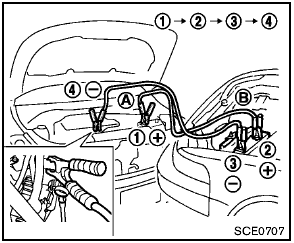 Nissan Rogue: Jump starting
Nissan Rogue: Jump starting
To start your engine with a booster battery, the instructions and precautions below must be followed.

- If done incorrectly, jump starting can lead to a battery explosion, resulting in severe injury or death.
It could also damage your vehicle.
- Explosive hydrogen gas is always present in the vicinity of the battery.
Keep all sparks and flames away from the battery.
- Do not allow battery fluid to come into contact with eyes, skin, clothing or painted surfaces. Battery fluid is a corrosive sulfuric acid solution which can cause severe burns. If the fluid should come into contact with anything, immediately flush the contacted area with water.
- Keep the battery out of the reach of children.
- The booster battery must be rated at 12 volts. Use of an improperly rated battery can damage your vehicle.
- Whenever working on or near a battery, always wear suitable eye protectors (for example, goggles or industrial safety spectacles) and remove rings, metal bands, or any other jewelry. Do not lean over the battery when jump starting.
- Do not attempt to jump start a frozen battery. It could explode and cause serious injury.
- Your vehicle has an automatic engine cooling fan. It could come on at any time. Keep hands and other objects away from it.


Always follow the instructions below.
Failure to do so could result in damage to the charging system and cause personal injury.
1. If the booster battery is in another vehicle B , position the two vehicles (A and B ) to bring their batteries into close proximity to each other.
Do not allow the two vehicles to touch.
2. Apply the parking brake. Move the selector lever to the P (Park) position. Switch off all unnecessary electrical systems (lights, heater, air conditioner, etc.).
3. Remove vent caps on the battery (if so equipped). Cover the battery with a firmly wrung out moist cloth to reduce explosion hazard.
4. Connect jumper cables in the sequence as
illustrated (1  2
2
 3
3
 4 ).
4 ).
For the vehicle equipped with Intelligent
Key system:
If the battery is discharged, the ignition
switch cannot be moved from the LOCK
position. Connect the jumper cables to
the booster vehicle B before turning
the ignition switch.

- Always connect positive (+) to positive (+) and negative (−) to body ground (for example, as illustrated), not to the battery.
- Make sure the jumper cables do not touch moving parts in the engine compartment and that the cable clamps do not contact any other metal.
5. Start the engine of the booster vehicle B and let it run for a few minutes.
6. Keep the engine speed of the booster vehicle B at about 2,000 rpm, and start the engine of the vehicle A being jump started.

Do not keep the starter motor engaged for more than 10 seconds. If the engine does not start right away, turn the ignition switch to the OFF position and wait 10 seconds before trying again.
7. After starting your engine, carefully disconnect
the negative cable and then the positive
cable (4  3
3
 2
2
 1 ).
1 ).
8. Replace the vent caps (if so equipped). Be sure to dispose of the cloth used to cover the vent holes as it may be contaminated with corrosive acid.
 Stowing the damaged tire and the tools
Stowing the damaged tire and the tools
1. Securely store the damaged tire, jack and
tools in the storage area.
2. Replace the luggage floor box.
3. Replace the lids on the luggage side boxes.
4. Close the luggage floor board.
5. Repl ...
 Push starting
Push starting
Do not attempt to start the engine by pushing.
Continuously Variable Transmission
(CVT) models cannot be push-started
or tow-started. Attempting to do so may
cause transmission damage. ...
See also:
Making a Call
Calls can be made using the following commands.
Dial or Call: The dial or call command can be used interchangeably to dial a
phone number or a stored name tag.
Digit Dial: This command allows a ph ...
Outside air temperature
The outside air temperature is displayed in 8F or
8C in the range of −58 to 1408F (−50 to 608C).
The outside air temperature mode includes low
temperature warning features.
- When th ...
Sheet Metal Damage
If the vehicle is damaged and requires sheet metal repair or replacement, make
sure the body repair shop applies anti-corrosion material to parts repaired or replaced
to restore corrosion protecti ...
